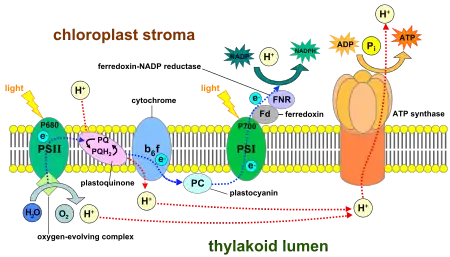Photosystem
Photosystems are functional and structural units of protein complexes involved in photosynthesis that together carry out the primary photochemistry of photosynthesis: the absorption of light and the transfer of energy and electrons. Photosystems are found in the thylakoid membranes of plants, algae and cyanobacteria which are located inside the chloroplasts of plants and algae, and in the cytoplasmic membrane of photosynthetic bacteria. There are two kinds of photosystems: I and II.

Reaction centers
At the heart of a photosystem lies the reaction center, which is an enzyme that uses light to reduce molecules (provide with electrons). This reaction center is surrounded by light-harvesting complexes that enhance the absorption of light.
Two families of reaction centers in photosystems exist: type I reaction centers (such as photosystem I (P700) in chloroplasts and in green-sulphur bacteria) and type II reaction centers (such as photosystem II (P680) in chloroplasts and in non-sulphur purple bacteria). The two systems are originally related, having diversified from a common ancestor.[1][2]
Each of the photosystem can be identified by the wavelength of light to which it is most reactive (700 nanometers for PSI and 680 nanometers for PSII in chloroplasts), the amount and type of light-harvesting complex present and the type of terminal electron acceptor used.
Type I photosystems use ferredoxin-like iron-sulfur cluster proteins as terminal electron acceptors, while type II photosystems ultimately shuttle electrons to a quinone terminal electron acceptor. Both reaction center types are present in chloroplasts and cyanobacteria, and work together to form a unique photosynthetic chain able to extract electrons from water, creating oxygen as a byproduct.
Structure
A reaction center comprises several (>24 or >33) protein subunits, that provide a scaffold for a series of cofactors. The cofactors can be pigments (like chlorophyll, pheophytin, carotenoids), quinones, or iron-sulfur clusters.[3]
In oxygenic photosynthesis
For oxygenic photosynthesis, both photosystems I and II are required. Oxygenic photosynthesis can be performed by plants and cyanobacteria; cyanobacteria are believed to be the progenitors of the photosystem-containing chloroplasts of eukaryotes. Photosynthetic bacteria that cannot produce oxygen have a single photosystem similar to either.
When photosystem II absorbs light, electrons in the reaction-center chlorophyll are excited to a higher energy level and are trapped by the primary electron acceptors.
Photoexcited electrons travel through the cytochrome b6f complex to photosystem I via an electron transport chain set in the thylakoid membrane. This energy fall is harnessed, (the whole process termed chemiosmosis), to transport hydrogen (H+) through the membrane, into the thylakoid lumen, to provide a potential energy difference between the thylakoid lumen space and the chloroplast stroma, which amounts to a proton-motive force that can be used to generate ATP. The protons are transported by the plastoquinone. If electrons only pass through once, the process is termed noncyclic photophosphorylation.
When the electron reaches photosystem I, it fills the electron deficit of the reaction-center chlorophyll of photosystem I. ATP is generated when the ATP synthase transports the protons present in the lumen to the stroma, through the membrane. The electrons may either continue to go through cyclic electron transport around PS I or pass, via ferredoxin, to the enzyme NADP+ reductase. Electrons and hydrogen ions are added to NADP+ to form NADPH. This reducing agent is transported to the Calvin cycle to react with glycerate 3-phosphate, along with ATP to form glyceraldehyde 3-phosphate, the basic building-block from which plants can make a variety of substances.
References
- Sadekar S, Raymond J, Blankenship RE (November 2006). "Conservation of distantly related membrane proteins: photosynthetic reaction centers share a common structural core". Molecular Biology and Evolution. 23 (11): 2001–7. doi:10.1093/molbev/msl079. PMID 16887904.
- Orf GS, Gisriel C, Redding KE (October 2018). "Evolution of photosynthetic reaction centers: insights from the structure of the heliobacterial reaction center". Photosynthesis Research. 138 (1): 11–37. doi:10.1007/s11120-018-0503-2. OSTI 1494566. PMID 29603081. S2CID 4473759.
- Jagannathan, B; Golbeck, JH (2009). Photosynthesis:Microbial. Encyclopedia of Microbiology, 3rd ed. pp. 325–341. doi:10.1016/B978-012373944-5.00352-7. ISBN 9780123739445.
External links
- Photosystems I + II: Imperial College, Barber Group
- Photosystem I: Molecule of the Month in the Protein Data Bank
- Photosystem II: Molecule of the Month in the Protein Data Bank
- Photosystem II: ANU
- UMich Orientation of Proteins in Membranes Superfamily » 1.1.002. Photosystems (7 families) - Orientations of Proteins in Membranes (OPM) database at the Wayback Machine (archived October 13, 2017) – Calculated spatial positions of photosynthetic reaction centers and photosystems in membrane
- Rutherford AW, Faller P (January 2003). "Photosystem II: evolutionary perspectives". Philos. Trans. R. Soc. Lond. B Biol. Sci. 358 (1429): 245–53. doi:10.1098/rstb.2002.1186. PMC 1693113. PMID 12594932.